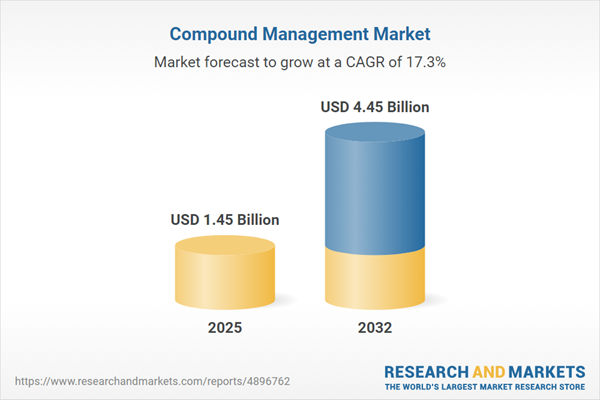Speak directly to the analyst to clarify any post sales queries you may have.
The compound management market is rapidly advancing, driven by innovation and evolving regulations across the pharmaceutical, biotechnology, and academic research sectors. Strategic investment in automation, analytics, and compliance systems is becoming essential for organizations seeking to maintain efficient and competitive operations in this space.
Market Snapshot: Compound Management Market Growth and Trends
The compound management market grew from USD 1.24 billion in 2024 to USD 1.45 billion in 2025. It is expected to continue growing at a CAGR of 17.27%, reaching USD 4.45 billion by 2032. Stakeholders across pharmaceuticals, biotech, and academic research are reshaping workflows and infrastructure in response to increased complexity and sample volumes, making advanced storage, tracking, and retrieval solutions a priority. Market expansion is fueled by robust innovation in laboratory informatics and automation, as well as a shift toward sustainable and compliant operations worldwide.
Scope & Segmentation of the Compound Management Market
- End Users: Academic and research institutions, Biotech companies, Contract research organizations, Government and regulatory agencies, Pharmaceutical companies
- Compound Types: Biologics (including cell therapy products, gene therapy products, monoclonal antibodies, recombinant proteins, and vaccines), Nucleotides, Peptides, Small molecules
- Applications: Agrochemicals, Drug discovery (covering hit identification, lead optimization, preclinical research, and target validation), Material science, Specialty chemicals
- Automation Levels: Fully automated systems, Manual systems, Semi automated systems
- Regions: Americas (United States, Canada, Mexico, Brazil, Argentina, Chile, Colombia, Peru), Europe, Middle East & Africa (United Kingdom, Germany, France, Russia, Italy, Spain, Netherlands, Sweden, Poland, Switzerland, United Arab Emirates, Saudi Arabia, Qatar, Turkey, Israel, South Africa, Nigeria, Egypt, Kenya), Asia-Pacific (China, India, Japan, Australia, South Korea, Indonesia, Thailand, Malaysia, Singapore, Taiwan)
- Key Companies: Thermo Fisher Scientific Inc., Danaher Corporation, Agilent Technologies, Inc., PerkinElmer, Inc., Tecan Group Ltd., Hamilton Bonaduz AG, Brooks Automation, Inc., Chemspeed Technologies GmbH, Hudson Robotics, Inc., Analytik Jena AG
Key Takeaways for Senior Decision-Makers
- Technology-driven integration of robotics and laboratory informatics enables precise, reliable compound storage and retrieval, improving workflow efficiency and sample traceability.
- Increasing adoption of modular automation and analytics transforms operational agility, supporting rapid adaptation to expanding chemical libraries and evolving research priorities.
- Stringent data integrity and compliance requirements influence organizations to implement comprehensive audit trails, closed-loop systems, and advanced environmental monitoring across compound management infrastructures.
- The complexity of biologics and cell-based therapies fuels demand for infrastructure supporting strict temperature control and high-integrity monitoring, while flexible formats remain vital for traditional chemical classes.
- Collaborative frameworks and interoperability standards are catalyzing cross-institutional research and enhancing IP protection, enabling more cohesive and scalable compound management ecosystems.
Tariff Impact on Global Compound Management Supply Chains
Recent U.S. tariff regulations on laboratory consumables, automation components, and specialty reagents have increased procurement costs and introduced supply chain uncertainty. Organizations are responding by renegotiating contracts, diversifying suppliers, and seeking alternative sourcing models to limit exposure. Equipment vendors are optimizing logistics to address these pressures. Adoption of modular, phased automation and distributed buffer inventories support more resilient operations as trade challenges persist.
Methodology & Data Sources
This report integrates secondary research—peer-reviewed journals, industry publications, regulatory documents—with primary qualitative interviews involving laboratory managers, R&D leaders, and technical experts. Segmentation analysis applies end user, compound type, application, automation, and geographic filters to deliver actionable insights. Findings were validated using data triangulation and iterative stakeholder review cycles.
Why This Report Matters
- Executive leaders access a comprehensive market overview to inform strategic planning, investment decisions, and competitive positioning in the compound management market.
- In-depth segmentation and regional analysis enable precise targeting of technology upgrades, supply chain strategies, and regulatory compliance initiatives.
- Actionable recommendations support implementation of scalable, efficient, and future-ready compound management infrastructures aligned with emerging market demands.
Conclusion
The compound management sector is evolving through technology, regulation, and shifting operational priorities. Leaders leveraging the insights from this report will be prepared to strengthen productivity, optimize compliance, and drive innovation in a dynamic global environment.
Additional Product Information:
- Purchase of this report includes 1 year online access with quarterly updates.
- This report can be updated on request. Please contact our Customer Experience team using the Ask a Question widget on our website.
Table of Contents
3. Executive Summary
4. Market Overview
7. Cumulative Impact of Artificial Intelligence 2025
Companies Mentioned
The companies profiled in this Compound Management market report include:- Thermo Fisher Scientific Inc.
- Danaher Corporation
- Agilent Technologies, Inc.
- PerkinElmer, Inc.
- Tecan Group Ltd.
- Hamilton Bonaduz AG
- Brooks Automation, Inc.
- Chemspeed Technologies GmbH
- Hudson Robotics, Inc.
- Analytik Jena AG
Table Information
| Report Attribute | Details |
|---|---|
| No. of Pages | 180 |
| Published | October 2025 |
| Forecast Period | 2025 - 2032 |
| Estimated Market Value ( USD | $ 1.45 Billion |
| Forecasted Market Value ( USD | $ 4.45 Billion |
| Compound Annual Growth Rate | 17.2% |
| Regions Covered | Global |
| No. of Companies Mentioned | 11 |









